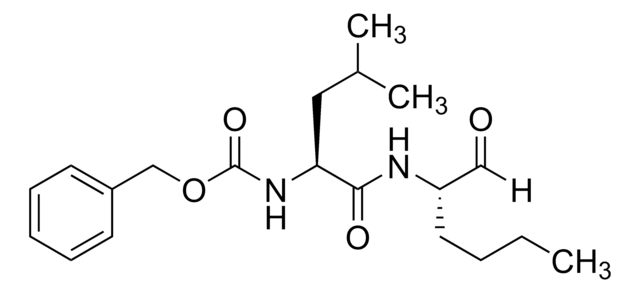E0514
E-64c
Calpain Inhibitor
Synonim(y):
(2S,3S)-trans-Epoxysuccinyl-L-leucylamido-3-methylbutane
About This Item
pochodzenie biologiczne
synthetic (organic)
Próba
≥98% (HPLC)
Postać
powder
rozpuszczalność
ethanol: 20 mg/mL, clear, colorless
temp. przechowywania
−20°C
ciąg SMILES
CC(C)CCNC(=O)[C@H](CC(C)C)NC(=O)[C@H]1O[C@@H]1C(O)=O
InChI
1S/C15H26N2O5/c1-8(2)5-6-16-13(18)10(7-9(3)4)17-14(19)11-12(22-11)15(20)21/h8-12H,5-7H2,1-4H3,(H,16,18)(H,17,19)(H,20,21)/t10-,11-,12-/m0/s1
Klucz InChI
SCMSYZJDIQPSDI-SRVKXCTJSA-N
informacje o genach
human ... CAPN1(823)
Działania biochem./fizjol.
Powiązanie
Kod klasy składowania
13 - Non Combustible Solids
Klasa zagrożenia wodnego (WGK)
WGK 3
Temperatura zapłonu (°F)
Not applicable
Temperatura zapłonu (°C)
Not applicable
Środki ochrony indywidualnej
Eyeshields, Gloves, type N95 (US)
Certyfikaty analizy (CoA)
Poszukaj Certyfikaty analizy (CoA), wpisując numer partii/serii produktów. Numery serii i partii można znaleźć na etykiecie produktu po słowach „seria” lub „partia”.
Masz już ten produkt?
Dokumenty związane z niedawno zakupionymi produktami zostały zamieszczone w Bibliotece dokumentów.
Klienci oglądali również te produkty
Nasz zespół naukowców ma doświadczenie we wszystkich obszarach badań, w tym w naukach przyrodniczych, materiałoznawstwie, syntezie chemicznej, chromatografii, analityce i wielu innych dziedzinach.
Skontaktuj się z zespołem ds. pomocy technicznej





